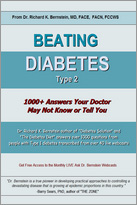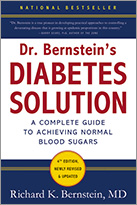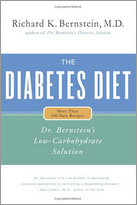LeVerne Watkins is a sixty-eight-year-old grandmother and associate executive director of a social service agency. When we first met, she had been taking insulin for two years, after developing Type II diabetes thirteen years earlier. Her comments relate in part to the effects of large amounts of dietary carbohydrate, covered by large amounts of insulin, while she was following a conventional treatment plan.
“In less than two years, my weight had increased from 125 to 155 pounds; my appetite was always ready for the next snack or the next meal. All my waking hours were focused on eating. I always carried a bag of goodies—unsalted saltine crackers, regular Coca-Cola, and glucose tablets. I always had to eat ‘on time.’ If I was a half-hour late at mealtime, my hands would begin sweating, I would become very jittery, and if in a social gathering or a conference or meeting at work, I would have to force myself to concentrate on what was taking place. During a meeting that I was chairing, the last thing I remember saying was, ‘Oh, I’m so sorry,’ before I toppled out of the chair to wake up and find myself in the emergency room of a local hospital.
“During a subway ride which generally took about 25 minutes, the train was delayed for close to 2 hours and—to my utter dismay—I had forgotten my bag of goodies. As I felt myself ‘going bananas,’ sweating profusely and perhaps acting a little strange, a man sitting across from me recognized my Medic Alert bracelet, grabbed my arm, and screamed, ‘She has diabetes!’
“Food, juice, candy bars, cookies, and fruit came from all directions. It was a cold, wintery day, but people fanned and fed me. And I was so grateful and so very embarrassed. I stopped riding the subway, and rescheduled as many meetings and conferences as I could to take place directly after lunch so that I would have more time before the next snack or meal would be necessary.
“I felt that I had no control over my life; I was constantly eating, I outgrew all my clothing, shoes and underwear included. I had been a rather stylish dresser since college days. Now I felt rather frumpy, to say the least. Once, I tried to discuss with my diabetologist how I was feeling about gaining weight and eating all the time. I was told, ‘You just don’t have any willpower,’ and ‘If you put your mind to it, you wouldn’t eat so much.’ I was very, very angry, so much so that I never consulted him again.
“On my own, I tried Weight Watchers, but the diet I had been given by the dietitian to whom the diabetologist had referred me did not mesh with the Weight Watchers diet. So along I limped, trying to accept that I was getting fatter each day, was always hungry, had no willpower, and most of the time was feeling unhappy.
“My husband was my constant support through all this. He would say, ‘You look good with a few more pounds….Go buy yourself some new clothes,’ especially when I would ask him to zip something that I was trying to squeeze into. He always clipped newspaper and magazine articles about diabetes and would remind me to watch specials on TV. He encouraged me to be active in the local diabetes association, and would accompany me to lectures and various workshops. Then, on Sunday, April 3, 1988—Easter Sunday—he clipped an article from the New York Times entitled ‘Diabetic Doctor Offers a New Treatment.’ Little did I realize that this thin news article would be a new beginning of my life with diabetes. I must have read it several dozen times before I finally met with Dr. Bernstein. Since that first meeting, I haven’t had one single episode of hypoglycemia, which I had formerly experienced very often. Following the regimen of correcting my high and low blood sugars, taking small doses and different kinds of insulin, and eating meals calibrated for specific amounts of carbohydrates and protein, my outlook brightened and I began to feel more energetic and more in charge of myself and my life. I could now hop on the train, ride the subway, drive several hours, and not fear one of those low blood sugar episodes. I started once again to exercise every day. My stamina seemed to increase. I didn’t have to push hard to accomplish my daily goals at work and at home. Within a couple of months, I was back to 129 pounds, had gone from size 14 to size 10, and ten months later to size 8 and 120 pounds. Even the swelling and pain in my right knee—arthritis, I was told—subsided. I feel great. My self-esteem and self-worth are whole again. I now take only 8 units of insulin each day, where I had previously been taking 31 units.
“I am also conquering my uneasy and frightening feelings about the long-term consequences of having diabetes. While I once thought that heart disease, kidney failure, blindness, amputations, and many other health problems were what the future probably held for me, I now believe that they are not necessarily outcomes of living with diabetes.
“But my life is not perfect. I still occasionally throw caution to the wind by eating too much and eating foods I know are taboo. Sticking with my diet of no bread, no fruit, no pasta, no milk, seemed easy when it was new, but now it is not easy, and loads of my efforts go into making salads, meat, fish, or poultry interesting and varied. My fantasies are almost always of some forbidden food—a hot fudge sundae with nuts, or my mother’s blueberry cobbler topped with homemade ice cream. But when all is told, I feel that I am really lucky. All my efforts have really paid off.”




